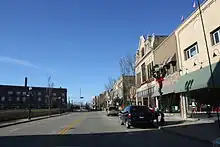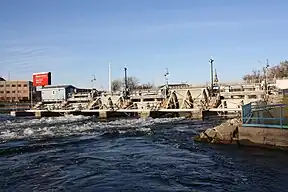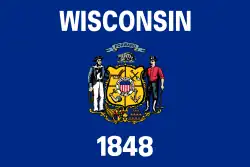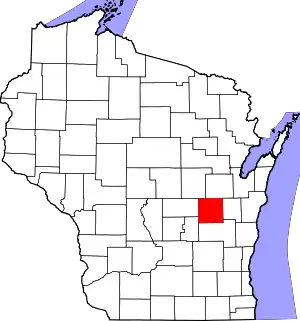Menasha, Wisconsin
Menasha (/məˈnæʃə/) is a city in Calumet and Winnebago counties in the U.S. state of Wisconsin. The population was 18,268 at the 2020 census. Of this, 15,144 were in Winnebago County, and 2,209 were in Calumet County. The city is located mostly in Winnebago County; only a small portion is in the Town of Harrison in Calumet County. Doty Island is located partially in Menasha. The city's name comes from the Winnebago word meaning "thorn" or "island".[7] In the Menominee language, it is known as Menāēhsaeh, meaning "little island".[8]
Menasha, Wisconsin | |
|---|---|
Downtown Menasha, a historic district The Menasha Dam | |
| Motto: Your Place on the Water | |
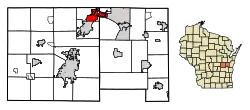 Location of Menasha in Calumet County, Wisconsin. | |
| Coordinates: 44°13′N 88°26′W | |
| Country | |
| State | |
| Counties | Winnebago, Calumet |
| First settled | 1835 |
| Incorporated as a town | 1848 |
| Incorporated as a city | 1874 |
| Named for | Winnebago word for "Island" |
| Government | |
| • Type | Mayor-council government |
| • Mayor | Don Merkes |
| Area | |
| • Total | 7.78 sq mi (20.16 km2) |
| • Land | 6.05 sq mi (15.66 km2) |
| • Water | 1.74 sq mi (4.50 km2) |
| Elevation | 755 ft (230 m) |
| Population | |
| • Total | 18,268 |
| • Estimate (2019)[4] | 17,873 |
| • Density | 3,021.5/sq mi (7,825.64/km2) |
| Demonym | Menashan |
| Time zone | UTC−6 (Central (CST)) |
| • Summer (DST) | UTC−5 (CDT) |
| ZIP code | 54952[5] |
| Area code | 920 |
| FIPS code | 55-50825[6] |
| GNIS feature ID | 1569330[2] |
| Website | menashawi.gov |
Menasha is home to the Barlow Planetarium and Weis Earth Science Museum, both housed at the University of Wisconsin-Oshkosh, Fox Cities Campus.
History
Native American History
Centuries prior to the existence of Menasha, ancestors of the Ho-Chunk occupied Doty Island. In the 1600s, the Fox Native Americans established a village just north of Menasha. A sneak attack by the French soldiers and traders resulted in the death of nearly all of the Fox Native Americans in the area. They are said to have piled the bodies in a large mound that became known as Butte des Morts, or "Hill of the Dead." The mound was a prominent landmark until it was destroyed by the construction of the railroad in 1863.
In 1836, the land that Menasha occupies was ceded to the United States in the Treaty of the Cedars. This opened up land for public sale, and territorial governor James Doty was one of the first investors in the land.
European settlement

Settlers first came to Menasha in 1835. At this point, Menasha was described as a wilderness with black bears.
In 1848, Doty and his associates, including Curtis Reed, formed the town of Menasha on the channel north of Doty Island.[9]
In 1849, Reed and Doty were successful in convincing the United States to place the navigational channel of the Fox-Wisconsin waterway through the north channel in Menasha.[9] In 1854 Menasha approved $150,000 in bonding to bring the Manitowoc & Mississippi Railroad in with the intention of establishing Menasha as the principal transportation axis in Wisconsin both in water and rail. Menasha incorporated as a city in 1874, and at that point was considered to be a transportation hub.[9]
The early 1900s saw a shift to industrial production of general and specialized papers.[9] At that time called "The Industrial City", Menasha was home to many paper mills including the George A. Whiting Paper Company Mill, the John Strange Paper Mill, Island Paper Company, and Gilbert Paper Company, to name a few. Menasha was also home to the George Banta Publishing Company which published textbooks, military manuals, yearbooks, and magazines.
Menasha Corporation also called Menasha home. It was established in 1849 by Elisha D. Smith as Menasha Wooden Ware.[10] It produced wooden containers like butter tubs and barrels and eventually became the world's largest wooden ware products manufacturer. After wooden ware products fell out of use in the early 1900s, Menasha Wooden Ware shifted to the corrugated packaging business, changing its name to Menasha Corporation.[10]
The 1980s saw expansion to the east with the City of Menasha crossing Oneida Street, eventually expanding all the way to Lake Park Road.[9]
Today, Menasha continues to be home to some of the world's largest corporations as well as innovative local companies including: Essity, Lakeside Book Company, IPG, Orbis (Menasha Corporation), Coveris, Sonoco, Affinity, Advanced Tool, McClone, and Faith Technologies.[9]
Geography
Menasha is located at 44°13′N 88°26′W (44.2129, −88.4362).[11] According to the United States Census Bureau, the city has a total area of 7.52 square miles (19.48 km2), of which, 6.03 square miles (15.62 km2) is land and 1.49 square miles (3.86 km2) is water.[12]
Demographics
| Census | Pop. | Note | %± |
|---|---|---|---|
| 1860 | 1,436 | — | |
| 1870 | 2,484 | 73.0% | |
| 1880 | 3,144 | 26.6% | |
| 1890 | 4,581 | 45.7% | |
| 1900 | 5,589 | 22.0% | |
| 1910 | 6,081 | 8.8% | |
| 1920 | 7,214 | 18.6% | |
| 1930 | 9,062 | 25.6% | |
| 1940 | 10,481 | 15.7% | |
| 1950 | 12,385 | 18.2% | |
| 1960 | 14,647 | 18.3% | |
| 1970 | 14,836 | 1.3% | |
| 1980 | 14,728 | −0.7% | |
| 1990 | 14,711 | −0.1% | |
| 2000 | 16,331 | 11.0% | |
| 2010 | 17,353 | 6.3% | |
| 2020 | 18,268 | 5.3% | |
| U.S. Decennial Census[13] | |||
Menasha is a city in the Appleton–Oshkosh–Neenah CSA, a Combined Statistical Area which includes the Appleton (Calumet and Outagamie counties) and Oshkosh–Neenah (Winnebago County) metropolitan areas, which had a combined population of 392,660 at the 2010 census and an estimated population of 409,881 as of 2019.
2020 census
At the 2020 census there were 18,268 people residing in the city. The population density was 3,021.5 inhabitants per square mile (1,166.6/km2). The racial makeup of the city was 85.9% White, 1.8% African American, 1.3% Native American, 3.1% Asian, 0.1% Pacific Islander, 3.0% from other races, and 4.7% from two or more races. Hispanic or Latino of any race were 7.2%.
2010 census
At the 2010 census there were 17,353 people, 7,405 households, and 4,415 families living in the city. The population density was 2,877.8 inhabitants per square mile (1,111.1/km2). There were 7,973 housing units at an average density of 1,322.2 per square mile (510.5/km2). The racial makeup of the city was 90.8% White, 1.2% African American, 0.7% Native American, 2.2% Asian, 0.1% Pacific Islander, 3.0% from other races, and 2.1% from two or more races. Hispanic or Latino of any race were 6.9%.[3]
Of the 7,405 households 30.7% had children under the age of 18 living with them, 43.6% were married couples living together, 10.9% had a female householder with no husband present, 5.1% had a male householder with no wife present, and 40.4% were non-families. 32.2% of households were one person and 9.9% were one person aged 65 or older. The average household size was 2.32 and the average family size was 2.95.
The median age was 36 years. 24.8% of residents were under the age of 18; 8.2% were between the ages of 18 and 24; 29.1% were from 25 to 44; 26.4% were from 45 to 64; and 11.6% were 65 or older. The gender makeup of the city was 49.4% male and 50.6% female.
2000 census
At the 2000 census there were 16,331 people, 6,951 households, and 4,233 families living in the city. The population density was 3,106.9 people per square mile (1,198.8/km2). There were 7,271 housing units at an average density of 1,383.3 per square mile (533.7/km2). The racial makeup of the city was 94.80% White, 0.54% African American, 0.61% Native American, 1.62% Asian, 0.02% Pacific Islander, 1.38% from other races, and 1.04% from two or more races. Hispanic or Latino of any race were 3.61%.[6]
Of the 6,951 households 31.7% had children under the age of 18 living with them, 46.1% were married couples living together, 10.8% had a female householder with no husband present, and 39.1% were non-families. 31.8% of households were one person and 10.0% were one person aged 65 or older. The average household size was 2.35 and the average family size was 2.99.
The age distribution was 25.6% under the age of 18, 9.6% from 18 to 24, 33.6% from 25 to 44, 19.4% from 45 to 64, and 11.8% 65 or older. The median age was 34 years. For every 100 females, there were 96.7 males. For every 100 females age 18 and over, there were 93.4 males.
The median household income was $39,936 and the median family income was $47,401. Males had a median income of $36,705 versus $25,176 for females. The per capita income for the city was $20,743. About 5.4% of families and 6.5% of the population were below the poverty line, including 8.5% of those under age 18 and 8.2% of those age 65 or over.
Government
The city of Menasha has a city council-mayor system of government. There are eight districts in the city, each represented by an aldermen. The council meets weekly with the mayor, Don Merkes.
Religion
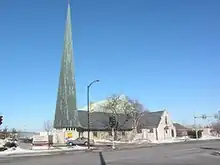
The Wisconsin Evangelical Lutheran Synod (WELS) has two churches in Menasha: Bethel Lutheran Church[14] and Mount Calvary Lutheran Church.[15]
Architect Harry Weese designed Menasha's St Thomas' Episcopal Church.
Education
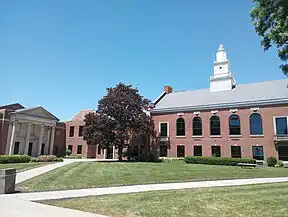
Menasha's Public School system, called the Menasha Joint School District has one high school, one middle school, and five elementary schools.
Menasha is home to the University of Wisconsin-Oshkosh, Fox Cities campus, a two-year campus part of the UW System.
Elementary schools
- Clovis Grove Elementary School
- Gegan Elementary School
- Jefferson Elementary School
- Banta Elementary School
- Butte des Morts Elementary School
- Trinity Lutheran School
- Bethel Lutheran School
- St. Mary Catholic Elementary School
Junior High/Middle schools
- Maplewood Middle School
- Trinity Lutheran School
- Bethel Lutheran School
High schools
- Menasha High School
- Fox Valley Alternative School
Colleges and universities
Economy
Companies headquartered in Menasha
- Faith Technologies
Tourism

Tourists visiting Menasha often go to Heckrodt Wetland Reserve, a 91-acre urban nature reserve with habitats including forested wetland, cattail marsh, open water, created prairie, open field, and upland forest.[16] The University of Wisconsin-Oshkosh, Fox Cities Campus houses the Weis Earth Science Museum, The Official Mineralogical Museum of Wisconsin; The Barlow Planetarium, The First Major Planetarium in Wisconsin; and the Communication Arts Center, a 51,000 square foot facility academic building with an art gallery and theatrical/musical performances.
Parks/Trails
The City of Menasha contains 7 neighborhood parks, 2 community parks, 2 Mini-parks, and 11 special purpose parks. The City of Menasha also has a public pool located in Jefferson Park.[17]
Smith Park is the oldest park in the Menasha Park system. The park celebrated its 100-year anniversary in 1997, making it one of the oldest city parks in the state.
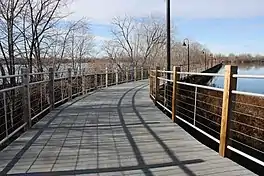
Several unique features make Smith Park an attraction worth seeing and an important community asset. A railroad caboose, presented to the Menasha Historical Society, commemorates the fact that Menasha was the birthplace of the original Wisconsin Central Railroad. At the southern end of the park are several Native American burial mounds - large settlements of Fox and Winnebago Native Americans once inhabited the area - and a natural amphitheater used for summer concerts. The north end of the park features semi-formal gardens planted each year with approximately 6,000 annuals, a setting that is a favorite for summer weddings. A gazebo funded with corporate donations was built in this area in 1997.[18]
Menasha has many public trails for bikes/pedestrians. One of the most used, Loop the Little Lake is a 3.5 mile route that links three (3) communities (Village of Fox Crossing, City of Menasha and City of Neenah).
Notable people
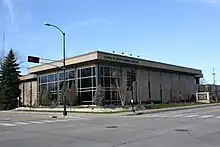
- Joseph H. Anderson, legislator
- John A. Bryan, U.S. diplomat
- Silas Bullard, jurist and legislator
- Elmer J. Burr, Medal of Honor recipient
- Arnold J. Cane, jurist and legislator
- Connie Clausen, television and Broadway actress, literary agent, and author of "I Love You Honey but The Season's Over", a memoir about Menasha
- Jean Pond Miner Coburn, sculptor
- Samuel A. Cook, U.S. Representative
- John Dollard, psychologist
- William Duchman, legislator and sawmill operator
- A. D. Eldridge, legislator and businessman
- William P. Grimes, legislator and businessman
- Eric Hinske, hitting coach for the Arizona Diamondbacks and former American League Rookie of the Year
- Joan Jaykoski, baseball player
- James C. Kerwin, Wisconsin Supreme Court
- Dave Koslo, MLB player for the New York Giants, Baltimore Orioles, and the Milwaukee Braves
- Jean Kraft, opera singer
- Publius Virgilius Lawson, six-term mayor, historian, manufacturer, lawyer
- George Liberace, musician and television performer, older brother of Liberace
- Jeff Loomis, heavy metal guitarist
- Thomas J. O'Malley, Lieutenant Governor of Wisconsin
- Curtis Reed, mayor of Menasha, businessman
- Richard J. Steffens, legislator
- Leslie J. Westberg, U.S. Air Force brigadier general
- Tony Wons, radio actor and commentator in the 1920s and 1930s; born in Menasha
References
- "2019 U.S. Gazetteer Files". United States Census Bureau. Retrieved August 7, 2020.
- "US Board on Geographic Names". United States Geological Survey. October 25, 2007. Retrieved January 31, 2008.
- "U.S. Census website". United States Census Bureau. Retrieved November 18, 2012.
- "Population and Housing Unit Estimates". United States Census Bureau. May 24, 2020. Retrieved May 27, 2020.
- "Menasha WI ZIP Code". zipdatamaps.com. 2023. Retrieved February 10, 2023.
- "U.S. Census website". United States Census Bureau. Retrieved January 31, 2008.
- Chicago and North Western Railway Company (1908). A History of the Origin of the Place Names Connected with the Chicago & North Western and Chicago, St. Paul, Minneapolis & Omaha Railways. p. 101.
- Hoffman, Mike. "Menominee Place Names in Wisconsin". The Menominee Clans Story. Retrieved October 5, 2018.
- "Menasha History". www.menashawi.gov. Retrieved July 27, 2023.
- "The History of Menasha". Menasha Packaging. Retrieved July 27, 2023.
- "US Gazetteer files: 2010, 2000, and 1990". United States Census Bureau. February 12, 2011. Retrieved April 23, 2011.
- "US Gazetteer files 2010". United States Census Bureau. Archived from the original on July 2, 2012. Retrieved November 18, 2012.
- "Census of Population and Housing". Census.gov. Retrieved June 4, 2015.
- "Bethel Lutheran Church".
- "Mount Calvary Lutheran Church (WELS)".
- "Heckrodt Wetland Reserve | Urban Nature Reserve | Menasha, WI". Heckrodt Wetland Reserve. Retrieved August 16, 2022.
- https://cms5.revize.com/revize/menasha/Park%20list2020.pdf
- https://cms5.revize.com/revize/menasha/Parks%20&%20Rec/4.OpenSpacePlan_Final_Resolution_8-2012.pdf
- "メナーシャ市|前橋市". www.city.maebashi.gunma.jp (in Japanese). Retrieved August 16, 2022.

